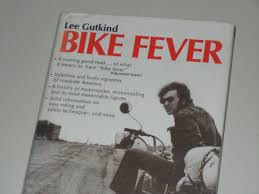March 24, 2018
Think Global, Act Local, and Immerse
 I began writing creative nonfiction not because of a personal story I wanted to tell, but a story I wanted to create—part of a big idea—and kind of a life dream. I wanted to ride across the U.S. on a motorcycle. I had been riding Hondas, Ducati’s, Yamahas, etc., commuting around town and gradually venturing on long—and longer – summer night and weekend cruises.
I began writing creative nonfiction not because of a personal story I wanted to tell, but a story I wanted to create—part of a big idea—and kind of a life dream. I wanted to ride across the U.S. on a motorcycle. I had been riding Hondas, Ducati’s, Yamahas, etc., commuting around town and gradually venturing on long—and longer – summer night and weekend cruises.
Finally, I bought a big black BMW – and took to the open road, traveling intermittently across the country for three years. Writing about my motorcycle odyssey began with a series of articles in a newspaper syndicate—and eventually led to a book.
The following year, my love for baseball-inspired essays and another book chronicling the season I traveled with a crew of major league umpires. Shorter pieces often lead to longer and more ambitious work like books, because they provide the writer with a certain amount of credibility. And as you learn, your appetite for knowledge and excitement about subjects with which you are familiar, expand. Or new ideas for subjects to write about in a story-oriented way emerge.
Ideas for topics are everywhere you look. An article in a local newspaper featuring a toddler about to undergo a seemingly impossible heart and liver transplant triggered my visit to the medical center, and subsequently, articles and books about the promise and perils of high tech medicine, especially organ transplantation. While writing that book, I noticed that most surgeons gave a lot more attention to adult patients than those in an adjoining pediatric hospital. There were many reasons for this, I soon found out, including ethical considerations and the fact that performing surgery—or any procedure, or caring for kids, generally required a totally different skill set and personality. I asked questions, and did some more basic research, which led to my second book about high-acuity healthcare—a year in the life of a children’s hospital.
I also noticed while roaming the medical center corridors, interviewing parents, their children, and the medical staff (and capturing dramatic life and death procedures), that the pediatricians, as kind and caring as they more, were not trained and equipped to deal with children with emotional and behavioral problems. So there again was a topic for another book—the challenge of childhood mental illness.
My experience at a children’s hospital made getting access into mental health clinics, hospital wards, and residential treatment centers for kids much easier because I knew the terrain. And finding a publisher for these books, because of my background from these other books, was also less challenging. In the creative or narrative nonfiction world, finding a specialty and sticking to it for a while is something to consider for a writer and makes the research and writing task a much more natural, less arduous transition. I even pushed the envelope a little further by following these books up with a book about veterinary medicine.
Later, after these four books, I had a conversation with my adolescent son about robots taking over the world that led to a book that explained how robots are made to think.
Two things to remember about all of these books—from transplantation to veterinary medicine to robotics – is that each subject had a large potential audience readership. That is to say, that taking care of kids, physically and emotionally, treating animals—from giraffes to gerbils—would be of interest to anyone in this country and across the world. Secondly and equally important is the fact that they all took place in my own hometown. Pittsburgh was the largest organ transplant center in the world, had a fine pediatric institution, a well-respected psychiatric facility for kids, and was the home of the famed Carnegie Mellon Robotics Institute think tank.
While it is true that I received publisher’s advances for these books, which allowed me to travel to other locations, most of my work was centered a few miles from my home. Which made immersion/observation work much easier and less costly. So anytime possible, when choosing a subject for the creative nonfiction book, remember that you don’t have to travel a thousand miles to write something interesting. It could be in your own backyard. Think globally for the largest readership possible, but act locally. You’d be surprised by all of the amazing things happening all around your hometown.